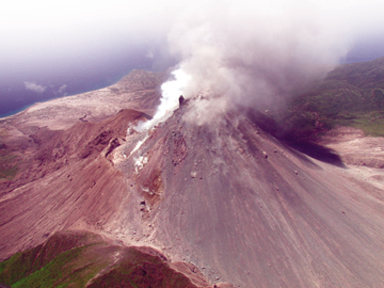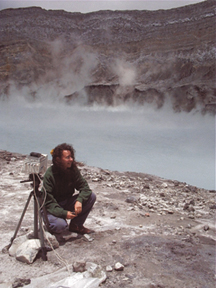 Gases
containing bromine and chlorine wreak havoc on the ozone layer, which sits in
the stratosphere, 15 to 50 kilometers above Earth. There, the chemicals break
ozone down into molecules of oxygen, weakening Earth’s shield against ultraviolet
radiation. Most atmospheric chemists believe that the single largest source
of bromine to the atmosphere is methyl bromide, a gas used to fumigate soils
and crops. But according to a report in the May 15 Nature, the largest
source may in fact be natural: Volcanoes may spew as much as 140,000 tons of
bromine oxide into the atmosphere each year.
Gases
containing bromine and chlorine wreak havoc on the ozone layer, which sits in
the stratosphere, 15 to 50 kilometers above Earth. There, the chemicals break
ozone down into molecules of oxygen, weakening Earth’s shield against ultraviolet
radiation. Most atmospheric chemists believe that the single largest source
of bromine to the atmosphere is methyl bromide, a gas used to fumigate soils
and crops. But according to a report in the May 15 Nature, the largest
source may in fact be natural: Volcanoes may spew as much as 140,000 tons of
bromine oxide into the atmosphere each year.Much of the bromine gas from volcanoes probably sits in the lower 10 kilometers of the atmosphere, the troposphere, making its impact on public health unclear, says paper co-author Ulrich Platt, an atmospheric chemist at the University of Heidelberg in Germany.
Researchers are measuring bromine emissions from Soufriere Hills on Montserrat to understand its contribution to tropospheric ozone depletion. Photo courtesy of Montserrat Volcano Observatory.
Ozone depletion in the stratosphere is clearly a concern because it increases the amount of ultraviolet light that makes it through to Earth’s surface, enhancing risks of skin cancer and eye cataracts. But tropospheric ozone, which often sits over cities in the summer, causes respiratory health problems — exacerbating asthma and bronchitis, for example. Bromine oxide emissions from volcanoes cut away at this lower-lying ozone.
“Tropospheric ozone has about tripled in the past century, mostly from pollution. And so you could argue that something that counters those effects could be good,” Platt says, “but things might not be that simple.” For example, some of the bromine oxide emitted from volcanoes may make it up into the stratosphere and harm the ozone layer, especially during large eruptions. Additionally, some ozone in the troposphere is beneficial because it produces radicals that remove noxious gases such as carbon monoxide.
Platt and his colleagues based their global emissions estimate on detailed measurements from a single active volcano on the Caribbean island of Montserrat. The team measured bromine oxide emissions from Soufriere Hills volcano using a technology they helped pioneer called differential optical absorption spectroscopy (DOAS). A small spectrometer sitting on a tripod 6 kilometers northwest of Soufriere Hills’ summit scanned through the plume puffing off the mountain. It recorded the spectrum of ultraviolet light that penetrated through the plume and compared it to light that did not travel through the plume. Bromine oxide absorbs specific bands of ultraviolet light, so differences in the two spectra correlated to concentrations of bromine in the plume. The researchers then multiplied bromine concentrations by wind speeds to estimate the total flux of bromine out of the volcano.
 “This
is the first remote sensing application to measure reactive bromine in a volcanic
plume,” says David Pyle, a volcanologist at the University of Cambridge.
“This
is the first remote sensing application to measure reactive bromine in a volcanic
plume,” says David Pyle, a volcanologist at the University of Cambridge.While remote sensing techniques similar to DOAS have been around since the 1970s, the resolution of the spectrometer used on Montserrat far exceeded the resolutions of its predecessors. This advance is particularly important for measuring bromine because its concentrations in the plume are very low, about one part per billion, Platt says. The research team also developed a software processing program to pull the relatively weak bromine signal out of the recorded spectra, says co-author Bo Galle, a physicist at Chalmers University of Technology in Sweden.
Nicole Bobrowski, lead author of the Nature study, kneels next to Poas, an active volcano in Costa Rica. She used a differential optical absorption spectrometer, pictured here on the tripod, to measure bromine emissions from Poas and Soufriere Hills on Montserrat.
The DOAS instrument also measured sulfur emissions from the mountain; the ratio of bromine to sulfur provided the key to extrapolating the single volcano measurements to many volcanoes worldwide, Platt says. Volcanoes emit large volumes of sulfur, and measurements from a host of volcanoes throughout the world have narrowed the estimate of the global sulfur flux to about 14 million tons per year. Assuming that the bromine to sulfur ratio found at Montserrat holds for other volcanoes, researchers calculated global bromine emissions, Platt says. The result: at least 30,000 tons of bromine each year, and possibly much more. But, he adds, the estimate is just a first cut. “Obviously, it is very uncertain. You have to assume all volcanoes are the same.”
Even though the constancy of the bromine to sulfur ratio is just a hypothesis, it is now one that can be tested, Pyle says. “The beauty of this technique is that you can measure bromine and sulfur simultaneously in real time. All we need to do now is take the measurement to a few other volcanoes around the world and confirm whether or not there is any systematic pattern.”
In the future, the authors hope to explore how much of the bromine emissions, if any, from Soufriere Hills and other volcanoes make it into the stratosphere to react with the ozone layer.
Greg Peterson

